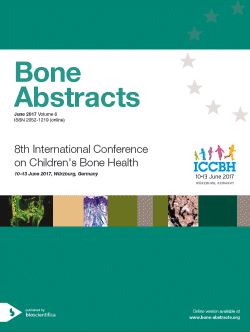
8th International Conference on Children's Bone Health
Treatment with a Novel activin receptor IIB ligand trap improves muscle mass and bone geometry in a mouse model of severe Osteogenesis Imperfecta
Tauer Josephine T. , Rauch Frank
The regulation of Smpd3 expression in skeletal tissues and its role in fracture healing
Manickam Garthiga , Li Jingjing , Hojo Hironori , Javed Amjad , Murshed Monzur
Mediating effect of muscle on the relationship of physical activity trajectories and bone outcomes: The Iowa Bone Development Study
Zymbal Vera , Baptista Fatima , Letuchy Elena M. , Janz Kathleen F.
Serious adverse effects of denosumab in adolescents treated for giant cell tumour of the bone: osteonecrosis of the jaw and rebound hypercalcaemia with acute kidney injury
Uday Suma , Gaston Louie , Grimer Robert , Joffe Jonathan , Hoegler Wolfgang
Role of type III sodium/phosphate co-transporters in the responsiveness of osteoblasts to extracellular inorganic phosphate
Michigami Toshimi , Yamazaki Miwa , Kawai Masanobu , Ozono Keiichi
Altered bone metabolism in Fanconi anemia results from defective mesenchymal stem cell differentiation
Mazon Melody , Julien Jacinthe , Ung Roth-Visal , Picard Sylvain , Bisson Sarah-Kim , Mac-Way Fabrice , Carreau Madeleine
Musculoskeletal system in adolescents with type 1 diabetes
Maratova Klara , Soucek Ondrej , Matyskova Jana , Hlavka Zdenek , Petruzelkova Lenka , Obermannova Barbora , Pruhova Stepanka , Kolouskova Stanislava , Sumnik Zdenek
Breech presentation is associated with neonatal and early childhood deficits in bone mass and size
Ireland Alex , Crozier Sarah , Heazell Alexander , Ward Kate , Godfrey Keith , Inskip Hazel , Cooper Cyrus , Harvey Nicholas
The cellular immune response in children with inflammatory bowel disease may mediate their low bone mineral density: a pilot study
ba0006lb10 | (1) | ICCBH2017
Effects of long-term sedentary behaviour on the cortical bone mass and distribution during growth: The HAPPY bone study
Duckham Rachel L , Rantalainen Timo , Rodda Christine , Timperio Anna , Hawley Nicola , Hesketh Kylie
ba0006lb11 | (1) | ICCBH2017
Bone health status as measured by DXA and pQCT in Indian Children with Thalassemia Major
Mandlik Rubina , Ekbote Veena , Ramanan Vijay , Kelkar Ketki , Pawar Jwala , Chiplonkar Shashi , Khadilkar Vaman , Khadilkar Anuradha , Padidela Raja , Mughal Zulf
ba0006lb12 | (1) | ICCBH2017
Correlation of the first fracture time and COL1A1/2 mutations in patients with Osteogenesis Imperfecta
Zhytnik Lidiia , Maasalu Katre , Duy Binh Ho , Reimann Ene , Prans Ele , Koks Sulev , Martson Aare
ba0006lb13 | (1) | ICCBH2017
Low dose of intravenous pamidronate therapy in quadriplegic children with osteoporosis
Moon Soonjung , Kim Soonki , Kwon Youngse , Lee Jieun
ba0006lb14 | (1) | ICCBH2017
P4HB recurrent missense mutation causing Cole-Carpenter syndrome: exploring the underlying mechanism
Balasubramanian Meena , Padidela Raja , Pollitt Rebecca , Bishop Nick , Mughal Zulf , Offiah Amaka , Wagner Bart , McCaughey Janine , Stephens David
ba0006lb15 | (1) | ICCBH2017
Consensus paper – Physiotherapy in children with OI
Semler Oliver , Mueller Brigitte , Mekking Dagmar
ba0006lb16 | (1) | ICCBH2017
Implementing an osteoporosis disease management program: what works and what doesn't work
ba0006lb17 | (1) | ICCBH2017
Bone health among boys with duchenne muscular dystrophy after initiation of glucocorticoids
Tung Joanna Yuet-ling , Chan Sophelia Hoi-shan
ba0006lb18 | (1) | ICCBH2017
Occurrence of vitamin D and vitamin K deficiency in children with low-energy fractures
Karpinski Michal , Chojnowska Sylwia , Maresz Katarzyna , Milewski Robert , Popko Janusz , Badmaev Vladimir
ba0006lb19 | (1) | ICCBH2017
Selected risk factors of fractures in children -own observation
Jakubowska-Pietkiewicz Elżbieta , Fendler Wojciech , Młynarski Wojciech , Chlebna-Sokoł Danuta , Matusik Paweł
ba0006lb20 | (1) | ICCBH2017
COL2A1 c.1609G>A (p.Gly537Ser) a pathogenic variant causing multiple skeletal abnormalities and severe short stature
Vlachopapadopoulou Elpis , Dikaiakou Irene , Manolakos Emmanouil , Panagiotopoulos Ioannis , Michalacos Stefanos
ba0006lb21 | (1) | ICCBH2017
Morbid obesity and respiratory failure in a child with pseudohypoparathyroidism type 1A
Gal Moran , Sarouk Ifat , Levy-Shraga Yael



